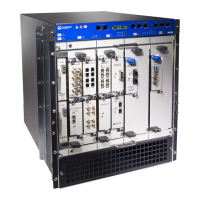Related
Documentation
M120 PICs Description on page 57•
• Connecting PIC Cables to the M120 Router on page 164
• Maintaining M120 PICs and PIC Cables on page 275
Replacing an M120 XENPAK Module
XENPAK modules are optical transceivers that can be removed from a PIC (for more
information, see “M120 PICs Description” on page 57).
XENPAK modules are hot-insertable and hot-removable. Removing a XENPAK module
does not interrupt PIC functioning, but the removed module no longer receives or transmits
data. To replace a XENPAK module, perform the following procedures:
•
Removing an M120 XENPAK Module on page 231
•
Installing an M120 XENPAK Module on page 232
Removing an M120 XENPAK Module
To remove a XENPAK module (see Figure 92 on page 232):
1. Place an electrostatic bag or antistatic mat on a flat, stable surface to receive the
XENPAK module. Have ready a rubber safety cap for the XENPAK transceiver and the
cable.
2. Attach an ESD grounding strap to your bare wrist and connect the strap to one of the
ESD points on the chassis.
3. Label the cable connected to the XENPAK module so that you can later reconnect it
to the correct module.
4. Disconnect the cable from the XENPAK module. Immediately cover the transceiver
and the end of the cable with a rubber safety cap.
WARNING: Do not look directly into a fiber-optic transceiver or into the
ends of fiber-optic cables. Fiber-optic transceivers and fiber-optic cable
connected to a transceiver emit laser light that can damage your eyes.
CAUTION: Do not leave a fiber-optic transceiver uncovered except when
inserting or removing cable. The safety cap keeps the port clean and
prevents accidental exposure to laser light.
5. Arrange the cable in the cable management system to prevent it from dislodging or
developing stress points. Secure the cable so that it is not supporting its own weight
231Copyright © 2018, Juniper Networks, Inc.
Chapter 27: Replacing Line Card Components

